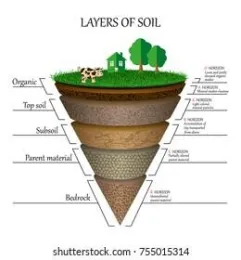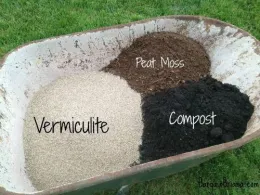Is your garden soil as productive as you want? Need to make some enhancements?
Soil amendments may be the solution to improve the quality of your soil, but before making any additions or changes to your soil, it is best to understand what soil amendments are and how they could improve your soil. Remember, soil improvement will not overcome poor design, plant choice, incorrect planting, and lack of care.
What is Soil?

Soil high in sand tends to drain fast and is predisposed to drought, whereas soils high in clay store water, are heavy, and not permeable to air and water. Loam soils feel like they have an equal amount of sand, silt, and clay.
Soil formation results in layers like the layers of a cake. The topsoil is where the most organic matter resides and where most biological activity occurs. The subsoil layer tends to be brighter in color and finer textured than the topsoil, and the subsoil is prone to be low in organic matter and is generally less fitting for plant growth.
What makes soil productive?
Any soil, no matter how compact, can be improved by adding organic matter, becoming a nutrient-rich environment for any plant. Like humans, roots and soil organisms breathe and require sufficient air and water to thrive. As a result, good soil is not “solid,” instead, between 40 and 60 percent of the soil volume is pores. The pores may be infused with water or air, making both available to plants. The minor pores store water, and the largest pores control the aeration and circulation of water through the soil and are primarily the result of earthworm or root growth.
Fertile soils are a dynamic community of many genera of fungi, bacteria, insects, and mites that depends on organic matter as a fuel source. Without these organisms, minimal soil formation would take place. Therefore, these organisms, with earthworms and plants, provide the glue that holds the soil together and gives it structure. Consequently, rich soil provides physical support, water, air, and nutrients to plants and soil-dwelling organisms.
What is an amendment?
Amendment: Any matter added into the soil to enhance its physical attributes, such as water retention, permeability, drainage, aeration, and structure. They are indirectly affecting plant growth.
Mulch: Organic or inorganic materials added to the soil surface to help inhibit weed growth, conserve moisture, and add organic matter to the soil as they break down.
Fertilizer: Directly affects plant growth by improving the supply of nutrients in the soil. Amendments may act as fertilizers by providing nutrients.
Organic material improves the soil structure and can be added to sandy soil to increase nutrient and moisture retention, help clay soils loosen, and provide better aeration and drainage. Compost is the most accessible organic material and can be purchased at garden supply stores. Examples of organic amendment include animal manure (Manure from farm animals such as cows, horses, sheep, goats, and chickens can be used, but never pig manure or pet waste, because of the risk of exposure to the parasites these may contain), compost, grass clipping, leaf mold, straw, wood chips, wood ash, and worm casting.
Inorganic amendments are either mined or artificial; they may improve soil texture and structure and aid in pH adjustment. Examples of inorganic amendments include greensand, gypsum, lime, perlite, pumice, and sand.
Topsoil may be added to raise the soil level to a minimum depth of 6 to 8 inches. If you add topsoil, it should be mixed into the existing soil. Do not just lay it on top of the old soil; this may create a layered profile, making it difficult for water to move through or for plant roots to penetrate.
Soil pH
The ideal soil pH ranges from 5.5 – 7.0. Soils with a pH of 5.5 or lower are too acidic. Lime can be applied to raise the soil ph. Soils with a pH of 7.0 or higher are too alkaline and can be modified with elemental sulfur. A soil analysis may help determine what kind of amendment may be needed.
In conclusion, knowing what type of soil your garden has will help determine what kind of amendment may be needed.
For more information:
http://ipm.ucanr.edu/TOOLS/TURF/SITEPREP/soilamen.html
https://marinmg.ucanr.edu/BASICS/COMPOST_-_OTHER_SOIL_AMENDMENTS/
https://extension.oregonstate.edu/news/add-organic-matter-improve-garden-soils
https://www.lotusland.org/greengarden/building-sustainable-gardens/
https://www.thespruce.com/compost-black-gold-for-your-garden-soil-1403130

